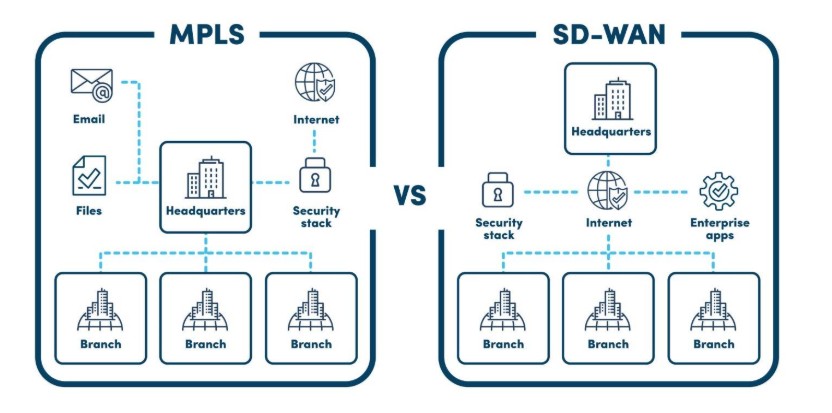By 2025, SD-WAN architecture has moved from buzzword to business-critical. Most large enterprises already use it in some form, whether to connect global offices, support remote teams, or speed up access to cloud apps.
The question has shifted. It’s no longer “What is SD-WAN?” but “How do we design SD-WAN architecture so it works at scale?”
And the stakes are high. Poorly designed SD-WAN can add complexity, cause performance headaches, and waste money. Well-designed SD-WAN architecture, on the other hand, can deliver faster applications, stronger security, and smoother cloud adoption.
This guide breaks down the design choices that separate success from failure.
What are the key components of SD-WAN architecture?
At a high level, SD-WAN architecture has three building blocks:
- Controllers
Controllers centralize orchestration, policy, and visibility so IT teams don’t have to configure every device individually. In enterprise deployments, these are usually distributed across multiple sites or clouds to provide redundancy and scale. - Edge devices
Edge appliances sit at branch offices, data centers, or in cloud platforms as virtual instances. They enforce the policies set by controllers and steer traffic in real time based on application type, performance conditions, and user needs. - Overlay fabric
The overlay fabric connects everything. It abstracts the complexity of the underlay — whether broadband, MPLS, 5G, or satellite — and combines them into a single, flexible transport pool that the SD-WAN can manage intelligently.
Together, these parts create an SD-WAN architecture that gives you central control while letting each site make local decisions, so the network runs smoothly without slowdowns or gaps.
Read our SD-WAN Enterprise Playbook for a deeper look at how to design, deploy, and optimize SD-WAN for your business
How do controllers and edge devices work in SD-WAN architecture?
Controllers and edge devices are the two sides of SD-WAN architecture. Controllers set the rules, and edge devices apply them. The way they work together decides how well the network scales and how resilient it is.
Controllers (centralized intelligence) Controllers aren’t a single box — they’re usually split into three roles:
- Orchestrator (management plane): the dashboard where IT teams set policies, push updates, and monitor the network. Often cloud-hosted so it can reach all sites.
- Policy controller (control plane): makes decisions about how traffic flows, such as giving Office 365 priority over bulk transfers, or rerouting calls if broadband performance drops. Vendors typically distribute these across regions to avoid bottlenecks.
- Route reflector or gateway (data plane entry/exit): manages tunnels between sites, advertises routes, and hands off traffic when it leaves the SD-WAN fabric for the internet, MPLS, or cloud providers.
To keep things resilient, controllers should be deployed in clusters across multiple geographies. Look for active-active redundancy, API integration with monitoring tools, and the ability to scale to thousands of tunnels.
Edge devices (distributed action)
Edge appliances sit at branches, data centers, or inside clouds. They enforce the policies from controllers and make real-time decisions about traffic based on conditions like latency or packet loss. Modern edge devices also consolidate other functions such as firewalls, intrusion prevention, and WAN optimization, reducing the number of appliances needed at each site.
When combined, controllers provide centralized intelligence while edge devices carry out distributed action. This balance allows SD-WAN architecture to be both scalable and resilient, without relying on a single point of failure.
What should I consider when choosing between SD-WAN and traditional WAN?
A lot of enterprises still wonder if they should keep MPLS or switch everything to SD-WAN. The reality is that most choose a mix of both — what’s often called a hybrid WAN.
- Traditional WAN (MPLS) is still valuable when you need guaranteed performance. It delivers low latency and minimal packet loss, which is critical for things like stock trading, real-time medical imaging, or factory automation. The downside is that MPLS is expensive, takes a long time to provision, and isn’t flexible when your needs change.
- SD-WAN architecture is designed for today’s cloud world. It’s cheaper to expand, supports multiple link types (broadband, 5G, satellite), and can prioritize traffic for SaaS apps like Microsoft 365 or Zoom. But it doesn’t always match the predictability of MPLS for highly sensitive workloads.
That’s why most enterprises use both. They keep MPLS for the small set of applications that demand rock-solid performance and use SD-WAN for everything else.

A typical hybrid WAN design includes:
- Dual underlays: Running MPLS alongside broadband, or broadband with 5G, so you have backup paths.
- Active-active tunnels: Both connections carry traffic at the same time, automatically failing over if one degrades.
- Application-aware routing: Critical apps (voice, ERP, trading) get steered to the most reliable path, while bulk traffic (software updates, backups) goes over cheaper broadband.
This approach balances predictability, flexibility, and cost efficiency. The design choice isn’t about picking MPLS or SD-WAN — it’s about deciding which workloads belong on which path.
How do cloud applications influence SD-WAN architecture design?
Cloud applications have completely reshaped how traffic flows across enterprise networks. Ten years ago, most data moved between branch offices and a central data center. Now, most traffic is headed for SaaS platforms like Microsoft 365, Salesforce, or Zoom, or into public cloud providers like AWS and Azure.
If SD-WAN architecture is designed around the old hub-and-spoke model — where everything is backhauled through headquarters — users end up with poor performance, higher costs, and frustrated teams. A cloud-first design solves this by rethinking how traffic enters and exits the WAN.
There are three key principles:
- Direct-to-cloud routing
Instead of dragging SaaS traffic through a central hub, SD-WAN routes it directly to the cloud. This reduces latency and improves application performance, especially for collaboration tools like Teams or Zoom that are highly sensitive to delay. - Local breakout
Branch offices and remote sites connect to the internet locally rather than routing through headquarters. This keeps SaaS traffic on the fastest path and avoids congestion in the core network. - Cloud security integration
Once you allow direct and local access, you can’t just rely on a single data center firewall anymore. SD-WAN architectures need to pair with cloud-based security frameworks like SASE (Secure Access Service Edge) or SSE (Security Service Edge). These deliver consistent inspection, filtering, and access control, no matter where the user connects.
To make this easier, most leading vendors now provide cloud on-ramps — automated integrations into SaaS and IaaS providers.
On-ramps optimize the connection into services like Microsoft 365, Salesforce, AWS, Azure, and Google Cloud, often by selecting the nearest access point and automatically monitoring performance. This means IT teams don’t have to manually configure and maintain complex routing for each service.
In short: Cloud is no longer the exception — it’s the majority of enterprise traffic. SD-WAN architecture that doesn’t prioritize cloud and SaaS will struggle to deliver the performance and security users expect.
How does SD-WAN architecture support multi-cloud and SaaS environments?
Enterprises no longer run workloads in just one place. Critical apps may sit in AWS, analytics in Google Cloud, ERP systems in Azure, while employees rely on SaaS every day through Microsoft 365, Salesforce, or Zoom. That creates a patchwork of connections that traditional WANs can’t handle efficiently.
SD-WAN architecture is built to unify this complexity. It extends the same overlay fabric across on-premises, cloud, and SaaS environments, so performance and security policies remain consistent no matter where traffic flows.
Key design features include:
- Virtual edge appliances in the cloud
Enterprises can deploy SD-WAN edges directly inside AWS, Azure, or GCP marketplaces. This brings the cloud into the SD-WAN fabric, allowing workloads in those environments to use the same tunnels, routing, and policies as any branch office.
- Pre-built integrations with cloud providers
Leading vendors offer “cloud gateways” or “on-ramps” that automate connectivity into IaaS platforms and major SaaS providers. These integrations select the closest entry point to reduce latency, balance loads across multiple regions, and automatically adjust if performance drops.
- SaaS traffic prioritization
Advanced SD-WAN platforms can identify SaaS traffic at the packet level and steer it along the best-performing path. Collaboration apps like Microsoft Teams, Zoom, or Webex are latency-sensitive, so prioritizing them ensures calls and video meetings stay smooth even when networks are congested.
- Consistent security policies everywhere
With users and workloads scattered across multiple clouds, a single perimeter firewall is no longer enough. SD-WAN architecture integrates with cloud-delivered security frameworks such as SASE or SSE, applying the same inspection, filtering, and access rules whether traffic originates in a branch, a data center, or the cloud.
By extending visibility and control into cloud and SaaS environments, SD-WAN architecture turns a fragmented multi-cloud footprint into a unified, manageable network. Instead of treating each provider as a silo, IT teams can design around a single fabric that adapts to wherever applications and users live.
What are the different types of SD-WAN deployment options?
When enterprises talk about SD-WAN deployment, they’re usually weighing how much of the design and operations they want to own versus what they hand off to a provider. The main options are:
- Do-it-yourself (DIY)
Your IT team designs, deploys, and manages the SD-WAN in-house. This gives you full control and the ability to customize policies, routing, and integrations. The trade-off is complexity — you need skilled engineers, 24/7 monitoring, and processes for upgrades and troubleshooting.
- Co-managed
A middle ground where you share responsibility with a provider. They may handle hardware staging, monitoring, or escalation while your team manages policies and day-to-day control. This works well for enterprises that want visibility and some control, but not the full operational burden.
- Fully Managed
The provider designs, deploys, and runs the SD-WAN end to end. They pre-configure hardware, manage the cloud dashboard, optimize traffic, and monitor the environment 24/7. Enterprises typically choose this when they want predictable SLAs, global reach, and less strain on internal resources.
The right option depends on resources, scale, and appetite for operational ownership. Enterprises with strong in-house networking teams may lean toward DIY or co-managed. Those without the expertise, or operating across many regions, often choose a fully managed service.
The design choices that matter most in SD-WAN architecture
The technology is proven. What separates a smooth rollout from a costly failure are the design choices you make up front. These decisions shape whether SD-WAN architecture becomes a stable foundation or another source of complexity.
- Centralized vs distributed control
Controllers bring consistency, but relying too heavily on a single control plane can create bottlenecks and failure points. Spread control across regions and clusters so the system stays resilient. At the same time, don’t give edge devices total independence — that risks policy drift. The best designs balance central visibility with distributed execution.
- DIY vs managed service
Running SD-WAN in-house gives you full control and flexibility, but it also demands significant networking expertise and 24/7 coverage. A managed service simplifies operations, provides global SLAs, and frees up internal teams — but usually comes with some vendor lock-in and less customization. Enterprises should decide based on skills, scale, and appetite for operational overhead.
- Security built-in vs bolted on
Security cannot be an afterthought. The strongest SD-WAN architectures include next-gen firewall (NGFW), intrusion prevention (IPS), and integration with SASE or SSE frameworks. Adding security later creates blind spots and extra cost. Cloud-delivered security should be part of the initial design, not a patch.
- Performance vs cost
Many enterprises move to SD-WAN for cost savings, but chasing the lowest spend often backfires. A smart design prioritizes critical apps like voice, video, and ERP over the best available path while sending bulk traffic (backups, updates) over cheaper broadband. Features like forward error correction (FEC), packet duplication, and dynamic multipath optimization ensure real-time traffic like Teams or Zoom performs consistently.
- Cloud-first vs data center-first
Designing a WAN around the corporate data center made sense ten years ago. In 2025, it undermines SaaS and multi-cloud performance. Modern SD-WAN architecture should assume cloud is the default destination for most traffic. Data centers are just one of many endpoints — not the hub of the network.
Finally, visibility and automation tie all of these decisions together. Centralized telemetry, API access, and AI-driven analytics let IT teams monitor application performance, predict issues, and integrate the WAN with broader operations. Without this layer, even a well-designed SD-WAN can become opaque and hard to manage.
Designing for what’s next
SD-WAN architecture is now the foundation of enterprise networking. The building blocks — controllers, edge devices, and overlays — are well understood. What sets successful deployments apart is how they’re designed.
When aligned with cloud-first strategy, embedded security, and the right operational model, SD-WAN architecture delivers agility, performance, and cost efficiency. When it’s designed poorly, it adds another layer of complexity. The difference lies in making deliberate, outcome-focused design choices.
Speak to BCM One to see how our team can design and manage the SD-WAN architecture that fits your enterprise.




